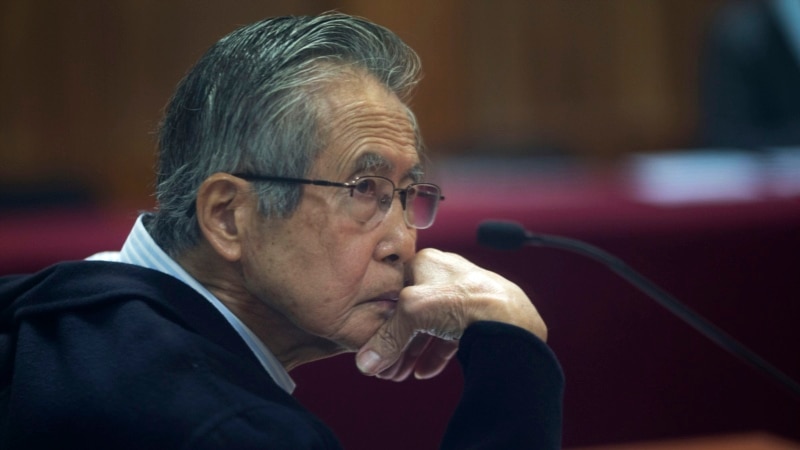The Peruvian justice questioned the imprisoned former president Alberto Fujimori on Friday at the request of the Supreme Court of Chile, which will decide whether to authorize Peru judge the ex-president for his alleged responsibility for thousands of forced sterilizations of poor women during his tenure (1990-2000).
The trial against Fujimori For forced sterilizations, he is suspended in Peru pending Chile granting a permit to try him for this accusation, because Fujimori was captured and extradited from Chile in 2007 to be tried for other crimes, including murder and corruption.
Peruvian judge Littman Ramírez said in a virtual hearing that Fujimori was accused of having carried out a family planning policy to reduce poverty and “show evidence of economic growth” with the support of international organizations including The Nippon Foundation. He added that his alleged mediate authorship will be evaluated in the injuries that caused the death of five women and in the serious injuries suffered by another 1,301 who were sterilized against his will.
Fujimori, who had a binasal oxygen cannula and was wearing a jacket with a hood, was sitting in front of a computer in a room of the prison for presidents in Lima accompanied by his lawyer. Judge Ramírez added that the family planning program was applied without adequate infrastructure, specialized personnel, as well as without the proper informed knowledge of the people. That resulted in “serious injuries to a large number of women and in some cases death,” he said.
The judge concluded that the “terrible” results of the program “were brought to the attention of President Fujimori, but even so he did not order the stoppage of its application.” “He sought to achieve greater economic growth through the reduction of poverty that he would achieve with the reduction of the birth rate,” explained the magistrate.
The former president, adjusting his glasses, replied that the accusation was “totally false.”
“What my government did was offer women, in particular, all modern and traditional family planning methods at the free choice of each of the interested parties,” he said.
Fujimori added that Peru in the 1990s had high maternal and infant mortality rates, especially in the southern Andes, including the Apurímac, Ayacucho and Huancavelica regions. “This accusation does not agree with the facts,” he concluded.
The judicial process in Peru includes three former health ministers during Fujimori’s tenure, between 1990 and 2000. In 2007, the Chilean court authorized Peru to try Fujimori for other cases, including human rights violations and corruption. The former president fled to Japan in 2000, hounded by corruption scandals, and arrived in Chile in 2005, where he was captured and extradited to Peru.
The case of forced sterilizations is one of the most emblematic in Peru, where, at the end of the 20th century, the political power sought to stop the birth rate of the most humble and indigenous people as part of a strategy to reduce poverty in the country, according to the Public Ministry.
Alejandra Ballón, a Peruvian anthropologist who has studied the case, stated that the massive forced sterilizations can be considered “the most serious crime against humanity that has been committed against our indigenous population” since colonial times, between the 16th and 19th centuries, when Peru it was dominated by the Spanish empire.
The sterilized women, all poor and without political power, fought for two decades for the Prosecutor’s Office to denounce the former president. The prosecutors’ preliminary investigation suffered several attempts to archive it in 2009, 2014, 2016 and 2018, according to advocates for the victims.
In March 2021, almost a quarter of a century after the events, a prosecutor, representing the more than 1,300 forcibly sterilized, denounced Fujimori and his former Health ministers.
The judicial process progressed so slowly that the judge took almost three months to read his decision, in the midst of hearings that were interrupted or postponed while the court claimed that the delay was due to other processes that prevented it from moving quickly.
Pablo Espinoza, the prosecutor who denounced the former president two years ago, said that the Fujimori government had focused on sterilizing the poorest. He cited hundreds of examples in one long session.
“There are no aggrieved women from other social sectors,” he said, adding that between 1996 and 2000, countless “health festivals” were organized in remote villages that included fireworks and music bands to attract women and then, through deception and coercion, sterilize them without informed consent.
According to Espinoza, the policy ordered by the Fujimori government also rewarded health officials who accumulated the most sterilizations with three travel tickets, but also threatened them with dismissal if they did not achieve their objectives.
According to the prosecutor’s office, 273,684 sterilizations were performed and 1,599 complications occurred.
Fujimori is serving a 25-year prison sentence for his mediate authorship in the murders of 25 Peruvians, including an 8-year-old boy, at the hands of a clandestine group of soldiers. He has three other convictions, two of them for corruption.
For two decades, activists who denounce forced sterilizations have demonstrated with skirts and thighs stained with red ink, or showing drawings of bloody fallopian tubes.
During this time, presidents from across the political spectrum have turned their backs on the activists, including Pedro Castillo (2021-2022), who recalled that his peasant family suffered sterilizations. Dina Boluarte, who succeeded Castillo after his dismissal in December, he has not spoken.
Connect with the Voice of America! Subscribe to our channel Youtube and activate notifications, or follow us on social networks: Facebook, Twitter and Instagram.














